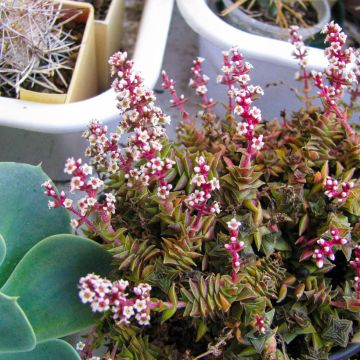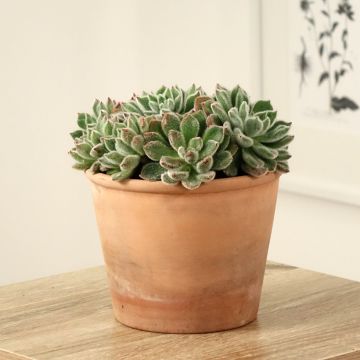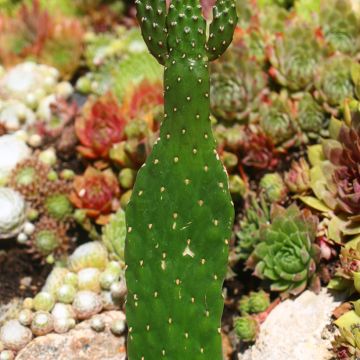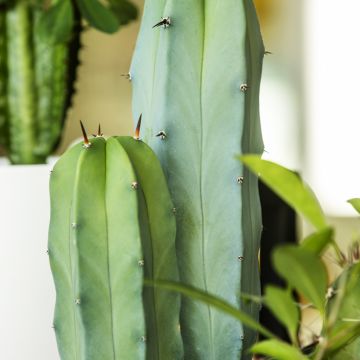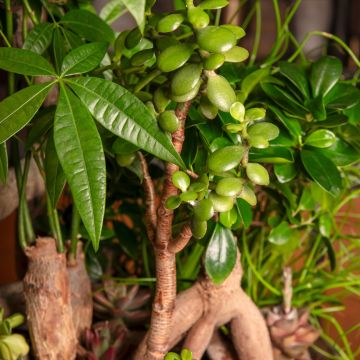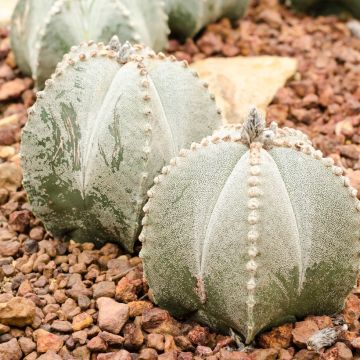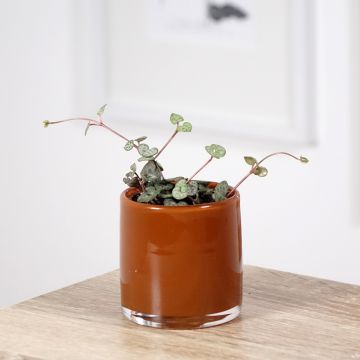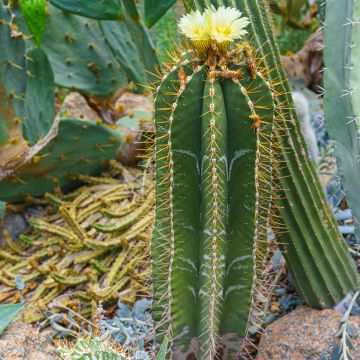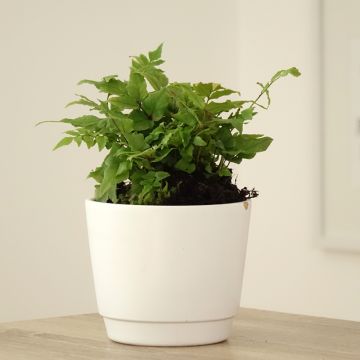

Cleistocactus winteri f. cristata - Golden rat tail cactus
Cleistocactus winteri f. cristata - Golden rat tail cactus
Cleistocactus winteri f. cristata
Golden rat tail cactus
This item cannot be shipped to the selected country
Delivery charge from 6,90 €
More information
Shipping country:
-
-
-
-
-
-
-
-
-
-
-
-
-
-
-
-
-
-
-
-
-
-
-
-
-
-
-
-
-
-
-
-
Schedule delivery date,
and select date in basket
This plant carries a 30 days recovery warranty
More information
We guarantee the quality of our plants for a full growing cycle, and will replace at our expense any plant that fails to recover under normal climatic and planting conditions.
From 7,90 € for pickup delivery and 6,90 € for home delivery
Express home delivery from 8,90 €.
Description
Cleistocactus winteri f. cristata, also known as the Golden Rat Tail, is a fascinating form of Cleistocactus winteri, prized for its wavy and sinuate habit that gives it an extraordinary appearance. Its stems, covered with small golden thorns, form irregular crests that intertwine. Native to the arid regions of Bolivia and Argentina, this cactus is hardy and easy to care for. Place it in a beautiful pot on a well-exposed windowsill!
Cleistocactus winteri f. cristata belongs to the Cactaceae family and originates from a natural mutation of Cleistocactus winteri, a creeping cactus native to Bolivia. This cristate form is distinguished by its flattened and sinuate stems, which grow in a disorderly manner instead of spreading into long trailing shoots. Indoors, it typically reaches 30 to 50 cm in diameter, forming a compact and wavy mass. Its epidermis, covered with small, fine golden thorns, gives it a fuzzy appearance. At maturity, it may produce tubular orange-pink flowers, although flowering is rare in indoor cultivation.
Cleistocactus winteri f. cristata requires a very bright exposure, with several hours of direct sunlight per day. It tolerates heat well and can be placed outdoors during the warmer months. This plant must be protected from the cold, as it cannot withstand temperatures below 5 °C. Its substrate must be very well-draining, composed of a mix of cactus compost, coarse sand, and perlite, to avoid excess moisture. Water moderately, allowing the soil to dry completely between waterings. In winter, it is best to reduce watering significantly to avoid the risk of rot. While not highly susceptible to diseases, it can still be affected by mealybugs.
Cleistocactus winteri f. cristata has small, fine thorns that can be irritating if they come into contact with the skin. It is recommended to handle it with care and to keep it out of reach of children and pets.
With its compact habit and undulations, Cleistocactus winteri f. cristata makes a striking statement in a bright living room, conservatory, or greenhouse. It is often grown alone to showcase its unique form but can be paired with other sculptural cacti of different shapes, such as Astrophytum myriostigma or Mammillaria elongata. A wide and shallow terracotta pot will improve drainage and highlight its original texture.
Report an error about the product description
Foliage
Plant habit
Flowering
Botanical data
Cleistocactus
winteri f. cristata
Cactaceae
Golden rat tail cactus
South America
Safety measures
Other Indoor cacti and succulents
View all →Location
Location
Maintenance and care
Potting advice, substrates and fertilisers
Disease and pest advice
Maintenance and care
This item has not been reviewed yet - be the first to leave a review about it.
Similar products
Haven't found what you were looking for?
Hardiness is the lowest winter temperature a plant can endure without suffering serious damage or even dying. However, hardiness is affected by location (a sheltered area, such as a patio), protection (winter cover) and soil type (hardiness is improved by well-drained soil).

Photo Sharing Terms & Conditions
In order to encourage gardeners to interact and share their experiences, Promesse de fleurs offers various media enabling content to be uploaded onto its Site - in particular via the ‘Photo sharing’ module.
The User agrees to refrain from:
- Posting any content that is illegal, prejudicial, insulting, racist, inciteful to hatred, revisionist, contrary to public decency, that infringes on privacy or on the privacy rights of third parties, in particular the publicity rights of persons and goods, intellectual property rights, or the right to privacy.
- Submitting content on behalf of a third party;
- Impersonate the identity of a third party and/or publish any personal information about a third party;
In general, the User undertakes to refrain from any unethical behaviour.
All Content (in particular text, comments, files, images, photos, videos, creative works, etc.), which may be subject to property or intellectual property rights, image or other private rights, shall remain the property of the User, subject to the limited rights granted by the terms of the licence granted by Promesse de fleurs as stated below. Users are at liberty to publish or not to publish such Content on the Site, notably via the ‘Photo Sharing’ facility, and accept that this Content shall be made public and freely accessible, notably on the Internet.
Users further acknowledge, undertake to have ,and guarantee that they hold all necessary rights and permissions to publish such material on the Site, in particular with regard to the legislation in force pertaining to any privacy, property, intellectual property, image, or contractual rights, or rights of any other nature. By publishing such Content on the Site, Users acknowledge accepting full liability as publishers of the Content within the meaning of the law, and grant Promesse de fleurs, free of charge, an inclusive, worldwide licence for the said Content for the entire duration of its publication, including all reproduction, representation, up/downloading, displaying, performing, transmission, and storage rights.
Users also grant permission for their name to be linked to the Content and accept that this link may not always be made available.
By engaging in posting material, Users consent to their Content becoming automatically accessible on the Internet, in particular on other sites and/or blogs and/or web pages of the Promesse de fleurs site, including in particular social pages and the Promesse de fleurs catalogue.
Users may secure the removal of entrusted content free of charge by issuing a simple request via our contact form.
The flowering period indicated on our website applies to countries and regions located in USDA zone 8 (France, the United Kingdom, Ireland, the Netherlands, etc.)
It will vary according to where you live:
- In zones 9 to 10 (Italy, Spain, Greece, etc.), flowering will occur about 2 to 4 weeks earlier.
- In zones 6 to 7 (Germany, Poland, Slovenia, and lower mountainous regions), flowering will be delayed by 2 to 3 weeks.
- In zone 5 (Central Europe, Scandinavia), blooming will be delayed by 3 to 5 weeks.
In temperate climates, pruning of spring-flowering shrubs (forsythia, spireas, etc.) should be done just after flowering.
Pruning of summer-flowering shrubs (Indian Lilac, Perovskia, etc.) can be done in winter or spring.
In cold regions as well as with frost-sensitive plants, avoid pruning too early when severe frosts may still occur.
The planting period indicated on our website applies to countries and regions located in USDA zone 8 (France, United Kingdom, Ireland, Netherlands).
It will vary according to where you live:
- In Mediterranean zones (Marseille, Madrid, Milan, etc.), autumn and winter are the best planting periods.
- In continental zones (Strasbourg, Munich, Vienna, etc.), delay planting by 2 to 3 weeks in spring and bring it forward by 2 to 4 weeks in autumn.
- In mountainous regions (the Alps, Pyrenees, Carpathians, etc.), it is best to plant in late spring (May-June) or late summer (August-September).
The harvesting period indicated on our website applies to countries and regions in USDA zone 8 (France, England, Ireland, the Netherlands).
In colder areas (Scandinavia, Poland, Austria...) fruit and vegetable harvests are likely to be delayed by 3-4 weeks.
In warmer areas (Italy, Spain, Greece, etc.), harvesting will probably take place earlier, depending on weather conditions.
The sowing periods indicated on our website apply to countries and regions within USDA Zone 8 (France, UK, Ireland, Netherlands).
In colder areas (Scandinavia, Poland, Austria...), delay any outdoor sowing by 3-4 weeks, or sow under glass.
In warmer climes (Italy, Spain, Greece, etc.), bring outdoor sowing forward by a few weeks.

































